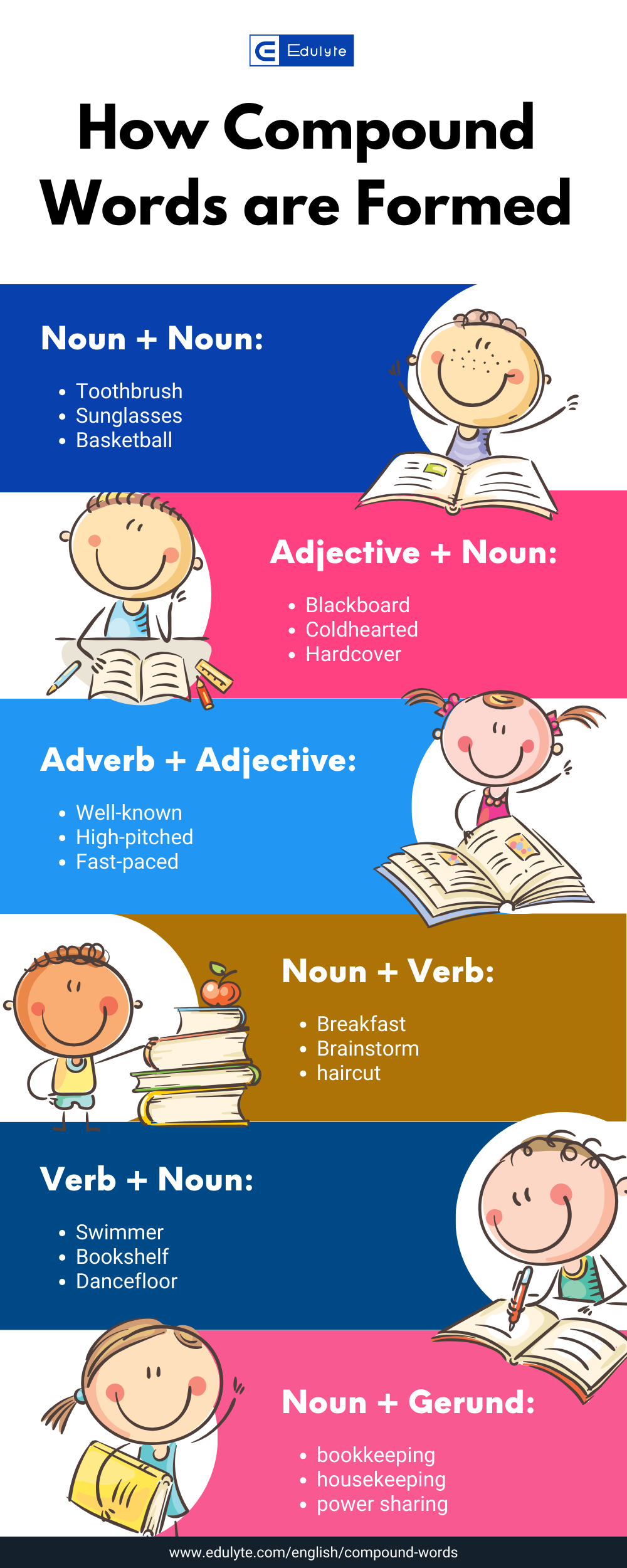
Learn English
Compound Words
Phonetics:
kɒmpaʊnd
wɜːd
Pronunciation:
Decoding Compound Words
Comprehensive Definition, Description, Examples & Rules
What are compound words
What are compound words? Compound words are formed by combining two or more separate words to create a new word with a distinct meaning. The individual words that make up a compound word retain their original meaning, but when combined, they create a new word that represents a related concept or object. Compound words can be formed by joining nouns, adjectives, verbs, or other parts of speech.
Compound words meaning hold great importance in language and communication. They are formed by combining two or more individual words to create a new word with a distinct meaning. Compound words offer a streamlined approach to conveying ideas by condensing multiple words into a single unit. They enhance clarity, simplify vocabulary, and enable seamless communication. Embracing the understanding and usage of compound words not only fosters precise expression but also contributes to language fluency and comprehension. This exceptional tool empowers you to enhance your language proficiency and elevate your communication skills to unprecedented levels of excellence.
Compound nouns emerge through the fusion of two or more words, resulting in a singular noun that encapsulates a coherent concept. These words may amalgamate with or without gaps or hyphens. Compound nouns encompass various forms, such as the blending of two nouns exemplified by “bookshelf,” the fusion of a noun and an adjective as demonstrated by “blackboard,” the amalgamation of a noun and a verb like “firefighter,” or the merger of a verb and a noun showcased by “honeybee.” Understanding compound nouns is important for building vocabulary and expressing ideas more precisely in writing and speech.
Types of Compound Words
Closed Compound Words
Closed compound words are a type of word formation in English grammar. They are formed by combining two or more words without any spaces or hyphens between them. In closed compound words, the individual words are fused together to create a new word with a distinct meaning.
Here are some closed compound words examples:
- Bedroom
- Baseball
- Highlight
- Newspaper
- Sunrise
- Firefly
- Worldwide
- Football
- Raincoat
- Butterfly
Closed compound words are a type of word formation where two or more words are combined to create a single word without any spaces or hyphens between them. They share some common characteristics. Firstly, closed compound words do not have spaces between the constituent words, such as “baseball,” “notebook,” or “sunflower.” Secondly, they maintain their original meaning and may have a distinct meaning that is different from the individual words combined. Lastly, closed compound words often follow specific spelling rules, like capitalizing the first letter of each constituent word in proper nouns, such as “New York” or “North America.”
Closed compound words play a vital role in language and communication. These words are formed by combining two or more words together without any spaces or hyphens. The importance of closed compound words lies in their ability to convey specific meanings and simplify communication. By joining words together, we create new words with unique definitions, enhancing our ability to express ourselves concisely. Closed compound words also contribute to the clarity and efficiency of written and spoken language, making our communication more effective and precise.
Open Compound Words
Open compound words are a type of word formation in English grammar where two or more words are combined to create a new word, but they are not joined together with hyphens or spaces. In open compound words, each component retains its own identity and meaning.
Here are some examples of open compound words:
- High school
- Full moon
- Ice cream
- Swimming pool
- Traffic light
Common characteristics of open compound words include clarity in meaning, flexibility in usage, and the ability to convey complex ideas by combining simple words. Examples of open compound words include “school bus,” “coffee table,” and “book club.”
Open compound words, such as “high school”, play a crucial role in language and communication. These words consist of multiple separate words that are not connected by hyphens or spaces. The significance of open compound words resides in their capacity to effectively communicate precise nuances, foster clarity, and augment comprehension.
Hyphenated Compound Words
Hyphenated compound words emerge by amalgamating two or more words through the utilization of a hyphen (-). They are often used to create new words or to clarify the meaning of a phrase. Hyphenation is commonly employed when combining adjectives, such as “well-known,” or when connecting a prefix or suffix to a base word, like “self-confidence” or “child-friendly.”
Here are some examples of hyphenated compound words:
- Well-known
- Self-confidence
- Child-friendly
- Up-to-date
- High-quality
- Open-minded
First, hyphenated compound words serve distinct purposes, such as enhancing clarity or emphasising particular components within a word. Subsequently, they predominantly function as adjectives that vividly portray and embellish nouns. Additionally, these compounds are frequently employed to articulate transient or evolving ideas. Noteworthy illustrations of hyphenated compound words encompass widely recognized, self-assurance, and current-to-the-moment.
Hyphenated compound words are crucial in language and communication. They combine words with a hyphen to form a single concept, clarifying meanings and improving readability. They’re often used for descriptive adjectives like “well-known” or “highly-regarded.”
Comparison of Different Types of Compound Words
Three distinct categories of compound words exist: closed, open, and hyphenated. Closed compound words are composed of a single word devoid of any spaces, exemplified by terms like “football” or “classroom.” Conversely, open compound words consist of separate words, as illustrated by phrases like “post office” or “high school.” Hyphenated compound words are written with a hyphen between the words, such as “well-known” or “mother-in-law.” Understanding the differences between these compound word types is important for proper spelling and writing.
Compound words come in different types, each with its own pros and cons.
Closed compound words:
- Pros: Easy to read and understand.
- Cons: Difficult to recognize and separate individual words.
Hyphenated compound words:
- Pros: Provide clarity and aid in understanding the meaning of the word.
- Cons: Can appear cumbersome and disrupt the flow of writing.
Open compound words:
- Pros: Easy to recognize and read individual words.
- Cons: May lack clarity and require additional context to understand their meaning.
When using compound words in writing and communication, it is important to follow certain guidelines to ensure clarity and consistency. For closed compound words, such as “blueberry” or “classroom,” the elements are combined into a single word without spaces. Hyphenated compound words, like “well-known” or “mother-in-law,” require hyphens to connect the different elements. Open compound words, such as “high school” or “full moon,” are written as separate words without any hyphens or spaces. Grasping and implementing these principles will facilitate the precise and compelling conveyance of your message.
How Compound Words are Formed
Compound words are created by combining two or more separate words, resulting in a new word that carries its own distinct meaning. These combinations can involve joining two nouns together (e.g., “bookshelf”), combining a noun with an adjective (e.g., “blueberry”), or merging an adjective with a noun (e.g., “highway”).
When it comes to forming compound words, there are some key rules to follow.
Compound words can be formed by combining two separate words, such as “black” and “board” to form “blackboard.”
Hyphens can be used to connect words in a compound word, such as “high” and “tech” to create “high-tech.”
Some compound words are created by combining two words together without any changes to their spelling or form.
It is important to understand the meaning and usage of compound words to ensure accurate and effective communication.
- Noun + Noun: toothbrush, sunglasses, basketball
- Adjective + Noun: blackboard, coldhearted, hardcover
- Adverb + Adjective: well-known, high-pitched, fast-paced
- Noun + Verb: breakfast, brainstorm, bookcase
- Verb + Noun: swimmer, bookshelf, dancefloor
- Adjective + Verb: quicken, brighten, soften

Transform Your English Skills
Free sign-up for a personalised dashboard, learning tools, and unlimited possibilities!
Sign up Now
Key Takeaways
- So what is a compound word? Compound words are formed by combining two or more words to create a new word with a distinct meaning.
- Compound words can be formed by combining different parts of speech, such as noun + noun, adjective + noun, and verb + noun.
- Compound words can be stressed on the first syllable, and the stress pattern can help identify compound words in English.
- Compound words are different from hyphenated words, as compound words are written as a single word without a hyphen.
Quiz
Question comes here
Frequently Asked Questions
Compound words in English are typically stressed on the first syllable of the word.
Yes, two or more words can be combined to create a compound word even if they are not related in meaning, as long as they form a new concept or idea.
A compound word is formed by combining two or more words into a single word, while a hyphenated word is created by using a hyphen to connect two words, typically when they act as a single concept but retain their individual meanings.
Yes, Edulyte’s worksheets provide helpful exercises and activities to improve your understanding of compound words, allowing you to practice identifying, creating, and using them effectively.


